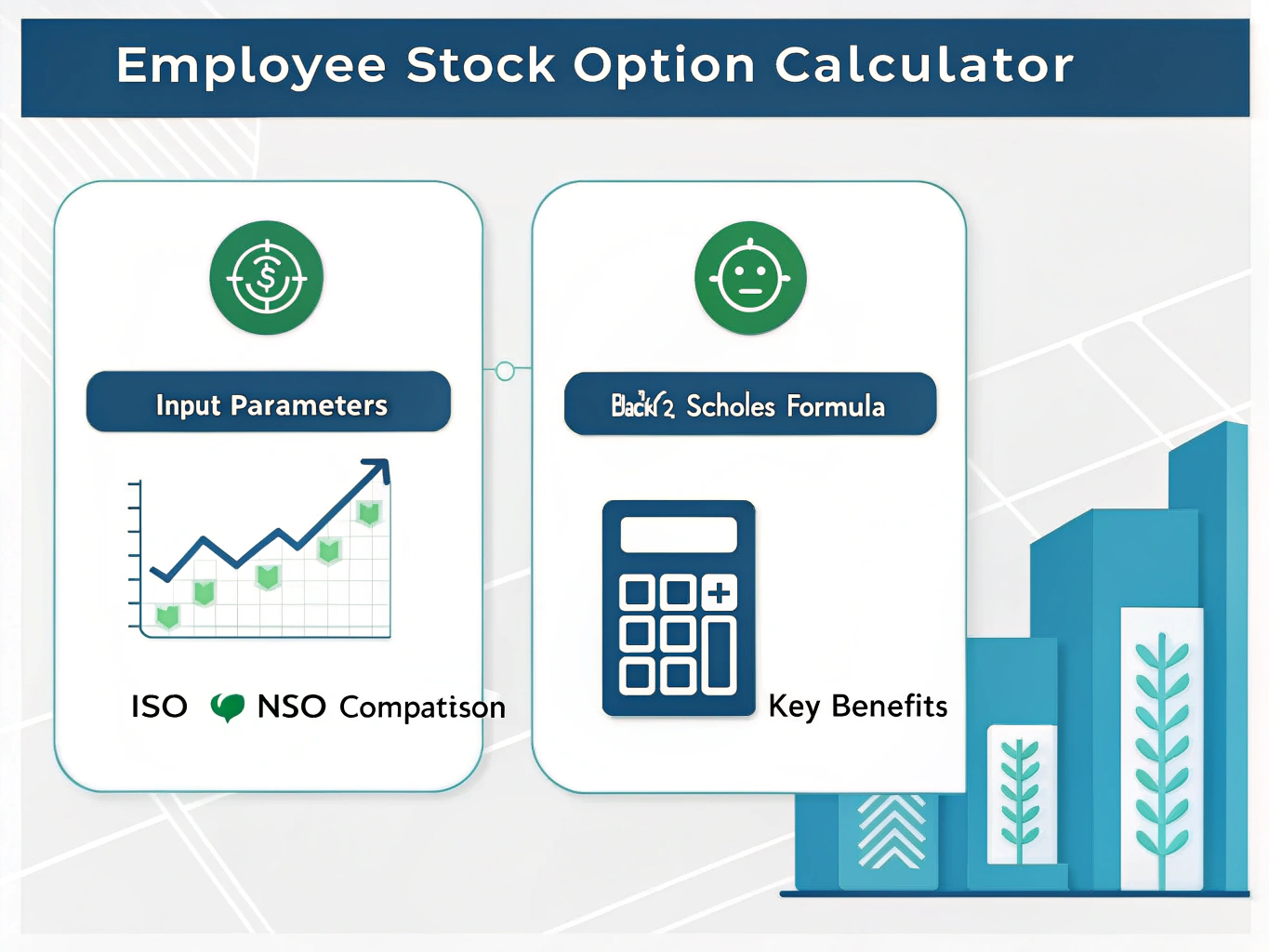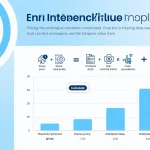Is this tool helpful?
How to Use the Employee Stock Option Calculator Effectively
Follow these simple steps to accurately calculate the value of your employee stock options using this Black-Scholes based calculator:
- Current Stock Price ($): Enter the latest market price of your company’s stock. For example, you might input 150.25 for a mature company or 22.90 for a growing startup.
- Strike Price ($): Use the exercise price stated in your stock option agreement. This could be 120.00 if granted recently or 10.75 for an earlier grant.
- Time to Expiry (Years): Fill in how many years remain until your options expire, such as 5.5 or 9.0, depending on your grant’s term.
- Risk-Free Rate (%): Input the annual risk-free interest rate, commonly based on current U.S. Treasury yields. Examples include 1.75 or 4.00.
- Volatility (%): Add the expected annual volatility of your stock’s price. Typical values might be 40.00 for private companies or 25.00 for stable public firms.
- Option Type: Select either Incentive Stock Option (ISO) or Non-Qualified Stock Option (NSO) according to your grant.
What the Employee Stock Option Calculator Does and Its Benefits
This calculator estimates the fair market value of your employee stock options using the Black-Scholes option pricing model, which considers market variables like stock price, strike price, time remaining, risk-free interest rate, and volatility.
The tool helps you understand the potential worth of your Incentive Stock Options (ISOs) and Non-Qualified Stock Options (NSOs), factoring in important tax adjustments such as the Alternative Minimum Tax (AMT) for ISOs.
- Provides realistic option valuations based on financial theory and market inputs
- Automatically calculates AMT adjustments for ISOs to support tax planning
- Enables comparisons between ISO and NSO benefits
- Supports better decisions on exercise timing and financial planning
- Helps you prepare for the financial impact of exercising your options
How the Black-Scholes Model Works in This Calculator
The Black-Scholes model uses these essential formulas to estimate option value:
$$ d_1 = \frac{\ln\left(\frac{S}{K}\right) + \left(r + \frac{\sigma^2}{2}\right) T}{\sigma \sqrt{T}} $$$$ d_2 = d_1 – \sigma \sqrt{T} $$Where:
- S = Current stock price
- K = Strike price
- r = Risk-free interest rate (expressed as a decimal)
- σ = Stock price volatility (expressed as a decimal)
- T = Time to expiration in years
Using these, the model calculates the theoretical call option value, which represents the benefit of holding the stock options until expiry.
Example Calculations Using the Stock Option Calculator
Example 1: Growth-Stage Technology Startup
- Current Stock Price: $30.50
- Strike Price: $12.00
- Time to Expiry: 7 years
- Risk-Free Rate: 2.0%
- Volatility: 50%
- Option Type: ISO
This input would result in a calculated option value that factors in the high volatility and long expiry, along with an AMT adjustment typical for ISOs.
Example 2: Mature Public Company Stock Grant
- Current Stock Price: $280.00
- Strike Price: $250.00
- Time to Expiry: 4 years
- Risk-Free Rate: 3.1%
- Volatility: 22%
- Option Type: NSO
With these values, the calculator estimates option value with lower volatility and no AMT adjustment since NSOs follow different tax rules.
Practical Uses for the Employee Stock Option Calculator
This tool helps you tackle common challenges in managing and valuing your stock options:
- Exercise Decision Making: Understand when exercising your options maximizes value by comparing current option worth to strike price.
- Tax Planning: Evaluate potential AMT liabilities for ISOs versus ordinary income taxes on NSOs when exercising.
- Portfolio Management: Assess how equity compensation fits into your overall investment strategy based on risk and reward.
- Job Offer Negotiations: Accurately value new equity grants to negotiate fairer compensation packages.
Important Strategic Considerations
Comparing ISO and NSO Options
ISOs generally offer tax advantages, but exercising them can trigger AMT, which affects your net gain. NSOs apply ordinary income tax but have more flexible exercise rules. Use this calculator to see how these differences impact your option value after taxes.
Impact of Volatility on Option Value
Higher stock price volatility usually increases the value of your options because it raises the chance of substantial stock price gains before expiration. Keep an eye on market trends and company stage to estimate volatility accurately.
Frequently Asked Questions About Employee Stock Options
What’s the key difference between ISOs and NSOs?
ISOs are granted mostly to employees and provide tax benefits if held under specific rules. NSOs can be granted to anyone but are taxed as regular income when exercised.
How does the AMT adjustment affect ISO valuation?
The calculator estimates a 28% AMT adjustment on the option value for ISOs, representing the extra tax you might owe. Knowing this helps you plan when to exercise to minimize tax costs.
When should I consider exercising my stock options?
Exercise when the stock price significantly exceeds your strike price and after analyzing tax implications. This tool helps you weigh immediate exercise benefits against holding for future gains.
How does volatility influence my stock option’s worth?
Volatility reflects the stock’s expected price swings. Greater volatility increases your potential upside, making your options more valuable. The calculator adjusts option value based on this input.
Can I evaluate multiple grants with this tool?
Yes, by entering each grant’s parameters individually, you can assess each option package separately to develop a comprehensive exercise and tax strategy.
How do changing market conditions impact option values?
Fluctuations in stock price, interest rates, and volatility all affect your option’s value. Recalculate regularly with updated inputs to make informed exercise decisions.
Important Disclaimer
The calculations, results, and content provided by our tools are not guaranteed to be accurate, complete, or reliable. Users are responsible for verifying and interpreting the results. Our content and tools may contain errors, biases, or inconsistencies. Do not enter personal data, sensitive information, or personally identifiable information in our web forms or tools. Such data entry violates our terms of service and may result in unauthorized disclosure to third parties. We reserve the right to save inputs and outputs from our tools for the purposes of error debugging, bias identification, and performance improvement. External companies providing AI models used in our tools may also save and process data in accordance with their own policies. By using our tools, you consent to this data collection and processing. We reserve the right to limit the usage of our tools based on current usability factors.







